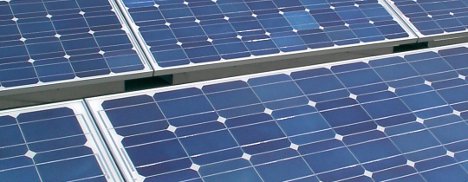Stephen Vance, Staff

In the coming months, the Municipality of Meaford will explore several potential green-energy initiatives after a plan brought forward by municipal staff found unanimous support from council.
The municipality has already embarked on some energy initiatives including the currently underway LED streetlight conversion, installation of occupancy sensors in some municipal washrooms, and upgraded energy efficient lighting at Meaford Hall.
The plan approved by council at their November 23 meeting will see the municipality explore the suitability and feasibility of installing rooftop solar panels on ten municipal buildings under the provincial MicroFIT program. The 10 buildings to be considered are:
- Meaford Fire Hall
- Stewart Street Operations Yard (56 Stewart Street)
- Compost Transfer Station (87 Stewart Street)
- 390 Sykes Street (Police Station/Co-Operators Building)
- Meaford Museum
- Harbour Pavilion and/or Washroom
- Harbour House
- Riverside Community Centre
- Bognor Community Centre
- Woodford Hall
“The application window under the existing tariff rate (38.4 cents) will close at the end of December 2015 with a reduced rate being paid starting in 2016 (29.4 cents) and as such, in order to maximize the potential return on investment, Council should endorse this process to allow the applications to be completed and submitted by the end of the year,” municipal Treasurer Darcy Chapman told council.
Chapman told council that a general plan has been created through a consultant to determine approximate construction costs for each project. Each rooftop project would cost approximately $32,500.
“Each project, if awarded a contract through the MicroFIT program, would require the Municipality to debt finance for a total of up to $325,000. This being said, after considering principle and interest payments along annual insurance premiums would still net significant excess revenue for the municipality. For smaller rooftop installations, annual maintenance fees are negligible given the majority of solar providers include monitoring services within the scope of work and the warranty periods are in excess of ten years,” said Chapman. “Based on current rates and estimated construction costs the Municipality could expect to generate $20,000 in combined net annual revenue from all ten sites and approximately $400,000 over the 20 year MicroFIT contract.”
Council has previously endorsed the application for two sites under the larger-scale Feed-In-Tariff (FIT) program, which would develop a 500kW ground-mounted solar project and a 100kW rooftop solar project.
“The closed landfill site on Centre Street and the rooftop at the 7 th Line Patrol-A garage would be utilized for these projects. The overall desire, should the Municipality be granted approval would be to generate revenue over a 20-year period assisting with tax supported program costs along with developing projects that will utilize renewable energy and generate significant carbon offsets throughout the life of the projects,” advised Chapman.
The MicroFIT Program was launched in 2009 as part of the Ontario government’s efforts to increase renewable energy in the province. The MicroFIT Program is a streamlined program for small renewable energy projects under the umbrella of the Feed-in Tariff (FIT) Program. The program provides property owners with the opportunity to develop a small renewable electricity generation project (10 kilowatts (kW) or less in size) on their property. Under this program, the Municipality of Meaford would be paid a guaranteed price over a 20-year term for all the electricity produced and delivered to the province’s electricity grid.
While the municipality could earn revenue from the FIT and MicroFIT programs, some municipal facilities could also be fitted with solar panels that would supply all of the required electricity required for a given facility.
“In conjunction with the larger FIT applications and the suggested MicroFIT applications, further analysis was completed on the remaining 50+ municipally owned facilities and properties looking for potential Net Metering projects. Net Metering is a process whereby rooftop or ground mount solar is designed and installed to cover 100% of a facility’s existing energy consumption needs. This process trades-off the existing electricity costs with those required to pay back long term debt n the capital costs of the panel installation. In many cases, facilities with a monthly bill of $200 or greater can benefit long term from this program,” advised Chapman.
After the analysis is completed, and should the applications under the MicroFIT program be successful, staff will report back to council with further analysis, and a summary of the next steps to be taken.











